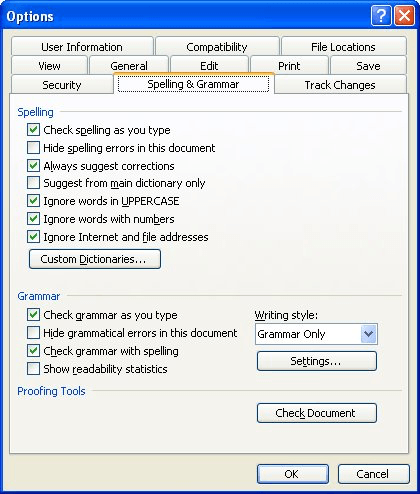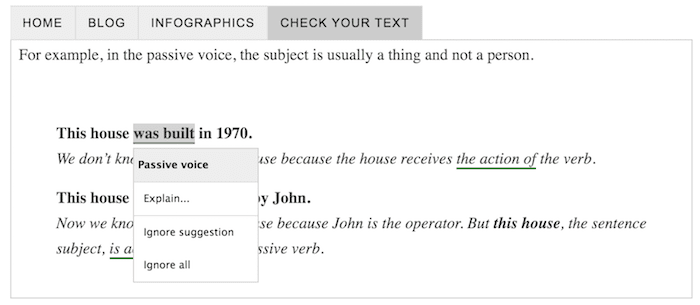- Passive voice definition at Dictionary.com, a free online dictionary with pronunciation, synonyms and translation.
- Oct 17, 2016 How to Use the Passive Voice Checker in Word 2013. The steps in this article were performed in Microsoft Word 2013. Once you have completed this guide, Microsoft Word will check for passive voice usage when you run the grammar checker. If you would like to stop checking for passive voice in Word 2013, then you can simply choose to uncheck the.
- Passive Voice Checker
- How Do I Check For Passive Voice On Mac For Word Search
- How Do I Check For Passive Voice On Mac For Word Document
The Passive Voice Sentences
The passive voice sentences turn the text weaker and make it sounds not so appealing. Comparatively, the active voice form of the sentence sounds more meaningful and appropriate. Many of the writers turn active voice sentences into passive voice ones to avoid plagiarism detection in their content. The use of active and passive voice corrector can make this problem simpler to sort out. Writing a sentence in passive voice requires the use of a comma. Therefore, it is divided into two parts to explain one thing.
Hello, Welcome to Microsoft Community. As of now is not possible to check use of Passive Voice in Word 2016. The Option to detect passive voice was available in the previous version of Word, however the feature is not available currently in Word 2016.
How to Distinguish Active and Passive Voice?
Word's Spell Check alerts all these instances. I would like to suppress this alert, but cannot figure out how to do so. Further, once I accept a passive voice usage during a spell check (using 'ignore'), the next time I repeat the spell check, Word does not remember that I told it to ignore passive voice, so I have to re-enter 'ignore' again. Myth: You should never use the passive voice. While the passive voice can weaken the clarity of your writing, there are times when the passive voice is OK and even preferable. Myth: I can rely on my grammar checker to catch the passive voice. Since the passive voice isn’t a grammar error, it’s not always caught.
When the subject is no longer active, but is, instead, being acted upon by the verb – or passive, it changes the normal word order of many active sentences. It is known as Passive Voice. When the subject performs the action denoted by the verb and with an action verb, it is said to be as Active Voice. It can be a bit complex to identify whether a sentence is active or passive by going through it personally. The app to detect passive voice in the text can be helpful to find the differences between both types of sentences.
Five Valid Reasons to Show Active Voice Better
When it comes to finding how to spot passive voice misuse, we usually make serious mistakes in it. It is necessary to spot the passive voice wrong use because the expert English authors always come in favor of the active voice instead. The active vs passive voice finder can do this job for you.


Firstly, have a look at some purposes when the active voice is better for your text.
- To create an authoritative tone.
- To describe a condition in which the actor is unknown or unimportant.
- To be tactful by not naming the actor.
- To keep the subject and focus consistent throughout a passage.
- To describe a condition in which the actor is unknown or unimportant.
How to Identify Passive Voice?
The passive voice sentences are not very complex to detect. There are some simple suggestions and tricks to figure out passive voice sentences.
Passive Voice Checker
- Go to find passive voice site. The online tool or webpage can help you out better if you’re not sure to do it personally.
- The use of “to be” in a sentence gives evidence of it as a passive.
- The presence of has, will be, being, will have been, was, is, am, are and have been shown that your spotted line is passive voice sentence.
- Look at what happened and look at who was responsible for doing it to detect the passive voice sentence.
The Passive and Active Voice Detector: How to Change Passive Voice into Active Voice?
The tool to replace passive voice sentence with an active voice one can do a better job. You can adapt to any passive voice sentences into the active voice by focussing on a few important examples.

This is a passive voice sentence:
“The post is read by the majority of my classmates.”
After changing it into the active voice sentence, it becomes:
“Most of my classmates are reading the post.”
This can be done by a good passive voice and active voice detector. Similarly, you can also do perform this task manually.
How Do I Check For Passive Voice On Mac For Word Search
The Job of Active Voice Checker to Turn Passive into Active Voice Form
The very first job is of the detection of the passive voice sentence. It requires you to know about the certain traits of passive voice sentences. This tool also finds the grammatical mistakes in the content. The next part is to figure out the punctuation errors in the given sentence. The vocabulary errors are also rectified so that the final version of the active voice sentence can be used. You simply have to copy and paste the sentence in the provided field. This will help you to save the time and mental energy required for the manual job. Make sure that the manual work requires you to know about the best writing technique.
How to Register to Use Active Voice Checker?
You have the simple process to sign for the website or tool required for active voice checking. The same procedure works for the passive voice identifier. Follow these steps and do this job in an ideal manner.
- Copy and paste the text into the given space. You can download it for free in any browser.
- Click on the ‘submit’ option and get the converted form of the text.
- You can also click on some other options i.e. grammar checking, punctuation identifier, etc.
- Now, you can enjoy the fully edited version of the document (that has been turned into an active voice sentence.)
Pros of Our Active Voice Passive Voice Detector
How Do I Check For Passive Voice On Mac For Word Document

There are plenty of options when you search for the active and passive voice detection tool. Our active voice checker online, free has a bundle of great features to get the best form of well-written sentences. Likewise, the passive voice checking tool is also worth-trying for the best results. Here are some amazing benefits of using our software. You’ll love to have it.
- Check the active and passive voice misuse instantly.
- The services are free and there’s no need to pay for using any feature.
- Installation is not required.
- Services are available in an extensive range (word count check, correct grammar and spelling check, plagiarism check, etc)
- Using with a chrome extension.
- Easy to access and simple.
- There is no limit to using this tool. You can enjoy all of its features as many times you like. This really sounds good to many people. You must try this tool and live with peace of mind.
Getting a flawless active or passive voice sentence is not a mere dream for you. Here comes a great passive and active voice detector that’s all set to turn the content easy to read and more meaningful. Try today!
Sheryl prefers passive voice for some of her writing (such as business documents and correspondence) rather than active voice. The grammar checker on Word always marks instances of passive voice. Sheryl would like to turn off the portion of the grammar checker that checks for passive voice so that it is not marked as an error.
Word allows you to choose which grammar checking rules it follows and which it doesn't. To change this particular setting (the one for passive voice), follow these steps:
- Display the Word Options dialog box. (In Word 2007 click the Office button and then click Word Options. In Word 2010 or in a later version display the File tab of the ribbon and then click Options.)
- Click the Proofing option at the left side of the dialog box. (See Figure 1.)
- Click the Settings button. Word displays the Grammar Settings dialog box. (See Figure 2.)
- Make sure there is no check mark next to the Passive Sentences option (Word 2013 and earlier) or the Passive Voice option (Word 2016 and later). (You'll need to scroll down a bit to see the option.)
- Click on OK to close the Grammar Settings dialog box.
- Click on OK to close the Word Options dialog box.
Figure 1. The Proofing options of the Word Options dialog box.
Figure 2. The Grammar Settings dialog box.